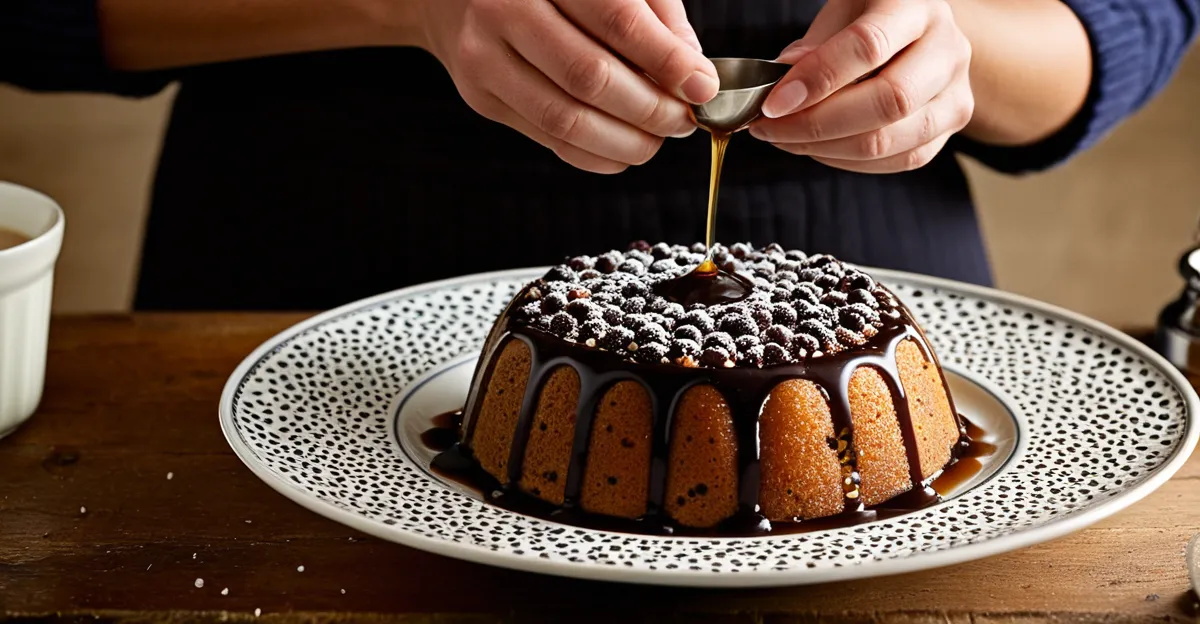Traditional Spotted Dick Pudding Overview
Spotted dick pudding is a quintessential British dessert, cherished for its rich history and comforting flavour. Its name comes from the “spotted” appearance created by dried fruits, often currants or raisins, dispersed throughout the suet-based dough. This pudding has long been a staple in British homes and pubs, symbolizing traditional culinary heritage and often evoking nostalgic memories.
The classic pudding recipe typically features simple ingredients: suet, flour, sugar, milk, and dried fruit. Suet, rendered beef or vegetarian fat, provides a distinctive moistness and fluffiness essential to the pudding’s texture. The preparation involves mixing these ingredients into a consistent dough, which is then steamed slowly to achieve that characteristic soft yet structured finish.
Have you seen this : How do you achieve the perfect balance of flavors in a bubble and squeak?
Popularity for spotted dick pudding persists due to its straightforward preparation and hearty, satisfying taste. It embodies the essence of British puddings, offering warmth and sweetness in equal measure. Understanding these fundamentals highlights why spotted dick remains an enduring favourite within the rich tapestry of British desserts.
Ingredients for Spotted Dick Pudding
Selecting the right spotted dick ingredients is crucial for an authentic flavour and texture. The classic pudding ingredients include:
Also read : How can you make a healthier version of a classic steak and kidney pie?
- Suet (typically 225g, either beef or vegetarian) provides the moistness and richness distinctive to suet puddings.
- Self-raising flour (~225g) forms the dough’s base, giving structure and lightness.
- Caster sugar (~100g) adds subtle sweetness without overpowering the dried fruits.
- Dried fruit, commonly currants or raisins (150g), creates the “spotted” effect central to this British dessert.
- Milk (about 150ml) binds the ingredients, ensuring a smooth dough.
For optimal results, choose high-quality suet—vegetarian suet is a popular alternative that remains true to the classic pudding recipe. Dried currants are preferred over raisins for their smaller size and gentle sweetness, enhancing the pudding’s texture and flavour naturally.
Optional substitutions include adding mixed peel or small chopped dates for variety, though these can alter the traditional taste profile. Some recipes also suggest using golden syrup or molasses for a richer sweetness, but these are optional extras rather than essential spotted dick ingredients. Understanding these suet pudding components helps maintain the pudding’s classic balance of softness, flavour, and satisfying density.
Preparing and Assembling the Pudding
Achieving the ideal spotted dick preparation starts by carefully combining dry and wet ingredients. Begin by sifting the self-raising flour and mixing in the suet and caster sugar evenly. This ensures the classic pudding ingredients are well distributed, preventing dense lumps. Next, fold in the dried fruit, which creates the “spotted” appearance characteristic of this suet pudding component.
Slowly add the milk to the dry mixture, stirring gently to form a thick, sticky dough. Overmixing can lead to a tough texture, so aim for just enough to bring the ingredients together. The dough should be firm but pliable, allowing for easy shaping.
For pudding assembly, line a pudding basin with greaseproof paper or lightly grease it to prevent sticking. Transfer the dough into the basin, pressing lightly to ensure an even surface but avoiding compression that might make the pudding dense. Cover the basin securely with a lid or foil to retain moisture during cooking. This careful preparation balances softness and structure, key to an authentic spotted dick pudding experience.
Steaming and Cooking Instructions
To master how to steam pudding, place the filled pudding basin in a large saucepan. Add boiling water until it reaches halfway up the basin’s side. Cover the basin tightly with foil and the pan’s lid to trap steam essential for even cooking.
Spotted dick cooking requires patience: steam for approximately 1.5 to 2 hours. Check water levels regularly, replenishing with boiling water to maintain consistent steam without dousing the pudding. This moist heat gently cooks the suet pudding components, resulting in the soft, spongy texture emblematic of British desserts.
A thermometer isn’t necessary; instead, test doneness by inserting a skewer or knife into the centre. If it emerges clean without sticky dough, steaming is complete. Avoid opening the cover too often, as heat loss can affect the final texture.
Common issues during steaming include water flooding the basin or the pudding drying out. These are often caused by insufficient sealing or low water levels. Using good-quality foil and a snug-fitting lid helps maintain the ideal steaming environment. Following these traditional British pudding method steps ensures a perfectly cooked, moist spotted dick pudding every time.
Serving and Enjoying Spotted Dick
When serving spotted dick, traditional British desserts etiquette suggests pairing it with a generous pour of warm custard, enhancing the pudding’s moist texture and subtle sweetness. Custard’s creamy richness balances the suet pudding components beautifully, making the dessert more indulgent. For variation, evaporated cream or vanilla ice cream can substitute custard, providing contrasting coldness and creaminess.
Presentation is key for an inviting experience. Slice the pudding into thick wedges to display the “spotted” interior clearly. Plating on a warmed dish prevents the pudding from quickly cooling, preserving that soft, spongy texture essential to this classic pudding recipe. Garnishing with a light dusting of powdered sugar or a sprig of fresh mint adds visual appeal without overpowering flavor.
For storage, spotted dick can be refrigerated in an airtight container for up to three days. Reheating is best done using gentle steam or a microwave on medium power to avoid drying out the suet pudding. These serving and enjoying tips ensure that each spotted dick pudding experience honors the tradition while maximizing flavour and comfort.
Variations, Substitutions, and Troubleshooting
Exploring variations of spotted dick can refresh this beloved British dessert while respecting its roots. Adding ingredients like mixed peel, chopped dates, or golden syrup offers flavor twists beyond the classic pudding recipe, but should be done sparingly to maintain balance.
For those with dietary restrictions, common pudding substitutions include using vegetarian suet for a meat-free option, or gluten-free flour blends to accommodate intolerance. Milk can be swapped with plant-based alternatives such as almond or oat milk, though these may slightly affect the pudding’s texture and moisture. These substitutions aim to preserve the signature softness and density found in a traditional spotted dick pudding.
Troubleshooting spotted dick involves addressing common issues like an overly dense texture or uneven cooking. Dense outcomes often result from overmixing the dough or compressing it too tightly during pudding assembly. To avoid this, gently combine ingredients and lightly fill the basin. Uneven cooking usually stems from inconsistent steam or improper sealing during the traditional British pudding method. Ensuring a tight foil cover and frequent water checks helps maintain steady steam for even heat distribution.
Adapting the recipe thoughtfully and following these tried methods guarantees a successful and satisfying spotted dick pudding experience every time.


